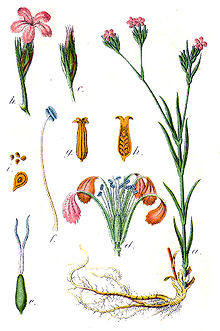Rough carnation
| Rough carnation | ||||||||||||
|---|---|---|---|---|---|---|---|---|---|---|---|---|

Rough carnation ( Dianthus armeria ) |
||||||||||||
| Systematics | ||||||||||||
|
||||||||||||
| Scientific name | ||||||||||||
| Dianthus armeria | ||||||||||||
| L. |
The Raue carnation ( Dianthus armeria ), whether tuft carnation called, is a species of the genus carnations ( Dianthus ) within the family of Caryophyllaceae (Caryophyllaceae). Its flowers are united in dense clusters and non-blooming shoots are completely absent. In some areas of Europe it is considered an endangered species.
description
Vegetative characteristics
The rough carnation grows as a biennial herbaceous plant and reaches heights of 30 to 60 centimeters. In the first year of its development, it forms a rosette of foliage leaves, from which the dense, short-haired flower sprout, richly branched above, rises in the following year. The stem and the leaves are coarsely hairy.
The constantly against arranged on the stem leaves are narrow lanceolate.
Generative characteristics
The main flowering time is from June to July, but occasionally it also extends into August. Two to ten flowers are in short-stalked, terminal clusters. The hermaphrodite flowers are up to 1 centimeter in diameter and are radially symmetrical and five-fold. The purple-colored petals are provided with white dots.
The number of chromosomes is 2n = 30.
Diseases
The rough carnation is attacked by the rust fungi Puccinia arenariae with Telien and Uromyces dianthi with Uredien and Telien.
Occurrence
The distribution area of Dianthus armeria includes central and southern Europe to the Caucasus and southern Sweden , especially the low mountain ranges . At altitudes over 1000 meters, however, it can only be found sporadically. As a location, forest fringes, dry bushes and grasslands, as well as more or less fresh, mostly low-lime and loamy soils are preferred. In Central Europe, it occurs primarily in fringe societies of the Pruno-Rubion association, for example in the Sarothamnetum, but also in societies of the Trifolion medii, Mesobromion erecti or the Sedo-Scleranthetea class.
In Germany we find them scattered around the edges of forests and bushes and in semi- arid grasslands . Due to the increasing "clearing of the landscape" and the resulting disappearance of the corresponding locations, the populations of Dianthus armeria are in decline and this species is therefore regionally endangered.
Common names
For the Raue Nelke exist or existed also the other German-language trivial names : Deptford Nelke ( Silesia ) and Thiernägelein ( East Prussia ).
swell
Individual evidence
- ↑ a b Erich Oberdorfer : Plant-sociological excursion flora for Germany and neighboring areas . 8th edition. Verlag Eugen Ulmer, Stuttgart 2001, ISBN 3-8001-3131-5 . Page 369.
- ↑ Peter Zwetko:Austria's rust fungi.Supplement and host-parasite directory to the 2nd edition of the Catalogus Florae Austriae, III. Part, Book 1, Uredinales. , 2000 (PDF; 1.8 MB).
- ^ Georg August Pritzel , Carl Jessen : The German folk names of plants. New contribution to the German linguistic treasure. Philipp Cohen, Hannover 1882, page 133. ( online ).
literature
- Gunter Steinbach (Ed.), Bruno P. Kremer u. a .: wildflowers. Recognize & determine. Mosaik, Munich 2001, ISBN 3-576-11456-4 .
- Wilfried Stichmann, Ursula Stichmann-Marny: The new cosmos plant guide. Franckh-Kosmos Verlag, ISBN 3-440-07364-5
Web links
- Dianthus armeria L., rough carnation. In: FloraWeb.de.
- Distribution map for Germany. In: Floraweb .
- Dianthus armeria L. In: Info Flora , the national data and information center for Swiss flora . Retrieved October 8, 2015.
- Distribution in the northern hemisphere at "Den virtuella floran"
- Thomas Meyer: Data sheet with identification key and photos at Flora-de: Flora von Deutschland (old name of the website: Flowers in Swabia )
- Data sheet with photos of the tufted carnation / rough carnation.


